Rapid globalization has had a profound effect on the documentation requirements of many forward-thinking companies. The need to quickly and accurately localize content for distribution to a host of different languages, while at the same time adhering to strict budgetary requirements, means that many companies have to rethink their legacy documentation technologies and workflows. XML and single source publishing have revolutionized content management, document exchange, and multilingual communications by separating content structure from appearance. An XML-based documentation system can greatly reduce costs through facilitating ease of conversion for delivery to many different data formats and types of applications. However, in order to take advantage of the full benefits XML provides, changes must be made in the traditional documentation workflow process. Throughout the documentation workflow, checks and balances are underway to ensure high quality content delivery. The single source concept ensures that these processes (i.e. conversion, edits, etc.) do not have to be repeated or reworked – that all content in the repository requires only minimal restructuring and promotion before being loaded to respective applications for delivery. In a global setting, where documentation needs to be simultaneously distributed to a variety of different languages, archival XML source documents can easily be translated by applying translation scripts as well as rendering scripts that can localize formatting attributes based on language-specific requirements. In addition, translation and maintenance costs can be significantly reduced by normalizing content for an international market.
XML Documentation
XML has long been lauded by the publishing industry as a cost-cutting solution to many process-related issues in content production and delivery. Having content converted to XML allows for enhancements in content organization, indexing, linking, storage, reuse and delivery/display. But just having content converted to XML does not allow it to reach its full benefit. XML and its associated technologies call for redesigned workflows to demonstrate their enormous potential. An optimized workflow for content publishers requires minimal process repetition. Once content is delivered, it is edited and converted to XML and stored in a centralized single source repository within the content management architecture. The XML files themselves will be minimally defined (tagged) so as to allow maximum flexibility. This repository now becomes the core storage mechanism for all deliverable content. It is on the delivery side that this process model demonstrates its primary benefits. Storing content in the single source repository transforms exporting the content to different formats and applications for delivery into a primarily automated process. There is no need for additional conversions or edits each time content is to be delivered to a different medium. In addition, any complications that arise will now be instantly recognized as process-oriented rather than data-oriented.
Translation
Legacy translation memory databases attempt to modularize content by segmenting source and translated text and storing it in a searchable database for reuse. Though these partially automated systems have been proven to reduce costs when compared to manual processes, the fact that translation is generally done at the sentence level means that is often taken out of context and therefore often loses its meaning. XML documents, on the other hand, are inherently modular and do not require the extensive parsing applied by traditional translation memory systems. In addition, XML assets can easily be encoded (with metadata, for example) and tracked throughout the translation process, ensuring that it remains closely associated with the contextual information often required by translators. An XML-enabled single source publishing model is designed to leverage content reuse, enabling organizations to save significant time and money through reducing or even eliminating repeated translations. XML gives publishers the ability to conceptually segment content assets for translation purposes, while at the same time keeping them closely tied to context. In the case of document frameworks, such as technical publishing, where text is often repeated in many different places, the ability to consolidate resources offers potentially enormous savings in translation costs alone.
Standards
A growing number of emerging standards are designed to aid in the localization of document frameworks. Methodologies for translation workflows and document exchange are designed to streamline content management architectures for multilingual environments. These include:
- Translation Memory eXchange (TMX) – a vendor-neutral XML standard for the exchange of translation memory data between tools and/or translation vendors
- Term Base eXchange (TBX) – an open XML-based standard for exchanging structured terminological data
- Open Lexicon Interchange Format (OLIF) – an open, XML-compliant standard for the exchange of terminological and lexical data
- XML Localization Interchange File Format (XLIFF) – an XML-based vocabulary for the exchange of localizable software and document-based objects and related metadata (XLIFF is also represented in the DITA Translation Subcommittee)
- Translation Web Services (TransWS) – specifies the calls needed to use Web services for the submission and retrieval of files and messages relating to localization projects
- XML-based Text Memory (xml:tm) – an open XML standard for embedding text memory directly within an XML document using XML namespace syntax
The extensible nature of XML lends itself to the creation of a wide variety of industry specifications, many of which enable businesses to streamline business processes and improving communication.
Formatting
In today’s global marketplace, organizations are often challenged with having to produce content in a variety of different languages. In a traditional documentation workflow model, this is an extremely arduous process. Legacy publishing software such as Quark, PageMaker, FrameMaker, etc. require expensive and resource-intensive desktop publishing and engineering processes for repurposing. In addition, these page layout applications are generally not well suited for delivery to multiple output formats. XML is inherently extensible, offering an infinite number of ways to define and structure markup. This flexibility also enables it to handle arbitrary data structures and convey information for both human users and machines for processing. In addition, XML also provides broad support for Unicode characters, enabling the automation of text normalization processes and making it natively accessible to multilingual environments. An XML documentation framework offers significant productivity enhancements to the localization workflow. The separation of content from structure and appearance that is inherent to XML gives companies the ability to translate text while at the same time maintaining the document structure dictated by an XML Schema or DTD. Any additional formatting that is required can also be simultaneously implemented through the application of XSLT and/or XSL:FO stylesheets.
Altova Tools for XML-based Single Source Publishing in a Global Environment
There are, of course, several different methods for internationalizing content with XML technologies. Included below are just a few of examples of how Altova tools can be used to streamline global publishing workflows. Multiple Output Formats
StyleVision is a graphical stylesheet design tool that enables users to create one design for simultaneous output to HTML, RTF, PDF, Word 2007 (OOXML), and Authentic electronic forms. 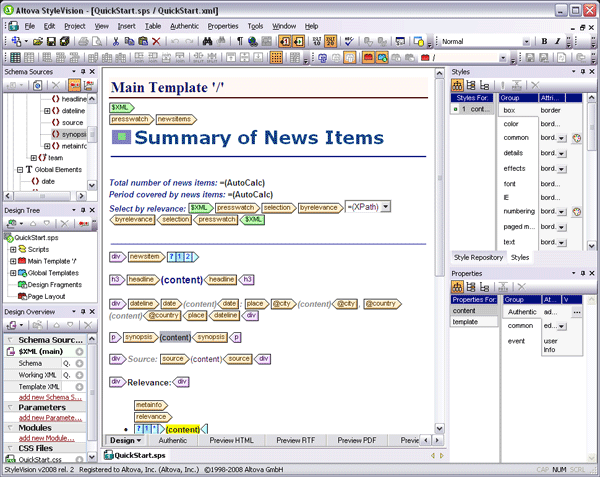 Language-specific Stylesheets
Language-specific Stylesheets
StyleVision also supports user-defined parameters that allow designers to maintain the modularity of their XML assets through the application of variables. This enables publishers to add unlimited new languages to their documentation by importing language-specific stylesheets and leaving XML content untouched. 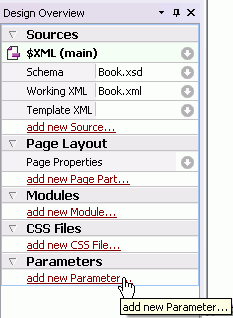 Of course, this approach to multi-lingual publishing can lead to the creation of an enormous number of stylesheets that are increasingly difficult to maintain. SchemaAgent, Altova’s XML-based file management system offers advanced support for managing XSLT (as well as XML Schema and WSDL) document relationships in a large publishing environment.
Of course, this approach to multi-lingual publishing can lead to the creation of an enormous number of stylesheets that are increasingly difficult to maintain. SchemaAgent, Altova’s XML-based file management system offers advanced support for managing XSLT (as well as XML Schema and WSDL) document relationships in a large publishing environment. 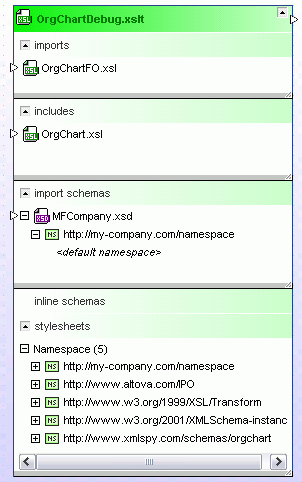 XSL Lang() Function
XSL Lang() Function
StyleVision also supports the XSL lang() function, which pulls the correct translation from XML source document(s) based on the xml:lang attribute. In this scenario, the translations could be stored together in one XML instance as specified in the xml:tm standard, or stored separately in language-specific directories. 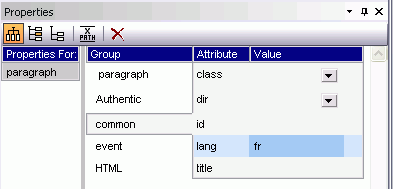 WYSIWYG Authoring Tool
WYSIWYG Authoring Tool
Authentic gives content contributors the opportunity to edit XML directly through e-Forms based on the stylesheet design created in StyleVision. Authentic is available through a free license so that it can be deployed to an unlimited amount of users without increasing costs. This enables translators to work directly with XML, rather than having it transposed at a later date for publishing. 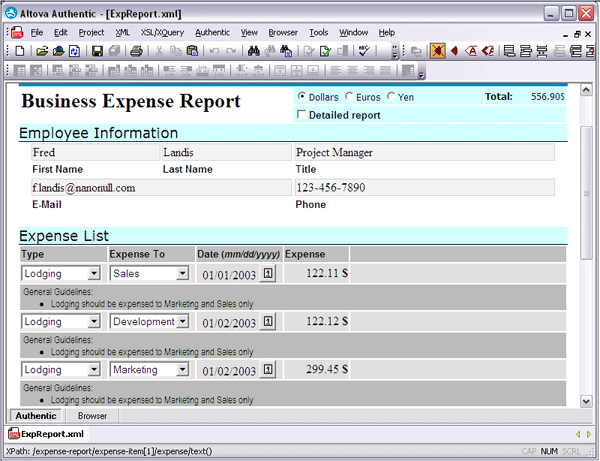 Authentic also includes a multi-lingual spell-checker that references built-in dictionaries in 18 different languages and vocabularies, allowing writers and translators to ensure the accuracy of their work.
Authentic also includes a multi-lingual spell-checker that references built-in dictionaries in 18 different languages and vocabularies, allowing writers and translators to ensure the accuracy of their work. 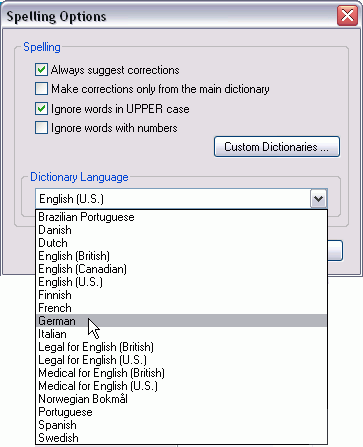
Conclusion
Single source publishing calls for the creation of a centralized store of content that can be accessed, reused, and deployed to a variety of different mediums. This enables the integrity of the content to be maintained throughout an infinite number of iterations. In a large documentation localization pool, the ability to adapt to different language and formatting requirements provides significant business advantages. There are several different approaches to maintaining single source content for a global audience. A careful and informed approach to preparing and storing content assets can ensure a variety of benefits including increased quality and consistency, reduction of translation costs, and increased longevity of translation investments. In addition, the XML-enabled single source publishing model facilitates document repurposing for delivery to a variety of different formats, making it accessible to end-users in HTML, RTF, PDF, Word 2007 (OOXML), etc. Incorporating this system within organizations documentation workflow processes enables the presentation accurate, consistent, and standardized information. XSL transformations apply format-specific processing instructions while ensuring that document content and structure remain intact. Migrating content to XML-based single source publication workflows requires some initial planning and technology investment, but the rewards are numerous. Cost reductions in translation and type-setting, faster time-to-market, and the ability to adapt to new language and data structures requirements in the future make the relatively small investment worthwhile. Discover how single source publishing can optimize your global documentation workflows with a free trial of StyleVision. Please note that StyleVision and the other products mentioned above are available as part of Altova’s software bundle, MissionKit, which offers XML and data management tools for distributed publishing environments. This technical brief and other resources are available in the Altova Library.
Microsoft PDC 2008 Recap
The Altova team exhibited at Microsoft PDC (Professional Developers Conference) in Los Angeles a couple of weeks ago. PDC is billed as a tradeshow for “leading-edge developers and software architects,” and, true to its promise, this event delivered a crowd of high level technology professionals. We enjoying catching up with a large number of current Altova customers and other .NET developers interested in learning more about using Altova MissionKit tools to solve XML, UML, and database design and development challenges. Our visitors were particularly interested in MapForce, a powerful and VERY affordable alternative to large-scale ETL solutions like BizTalk and SSIS, and UModel, for its advanced UML support and integration with Visual Studio.We also took this opportunity to introduce visitors to the MissionKit and the huge savings offered through downloading it as an integrated development suite. The MissionKit was also a popular conversation topic because of the powerful plugins it offers for Visual Studio – in XMLSpy, MapForce, and UModel.One of the most enjoyable memories that this exhibitor has in particular from PDC is the large number of current customers who brought their friends by to encourage them to try our tools – telling them how they could solve problems that they had previously discussed and even answering questions from other visitors listening in! It really made me recognize and appreciate the enormous amount of support that Altova and Altova tools have from the .NET community… Thank you everyone. We hope that you continue to enjoy Altova MissionKit tools and to see you all again the next time PDC rolls into town!Lastly, here’s a video from the show: Allyson and David demoing UModel live at PDC.
New video available: UML round trip engineering
We’ve just uploaded a new Flash video in the UModel UML modeling series titled "Round Trip Engineering." The Round Trip Engineering video describes how to move your software modeling project ahead either by working directly in the source code or by expanding and refining your UML model, while keeping both the code and model in sync.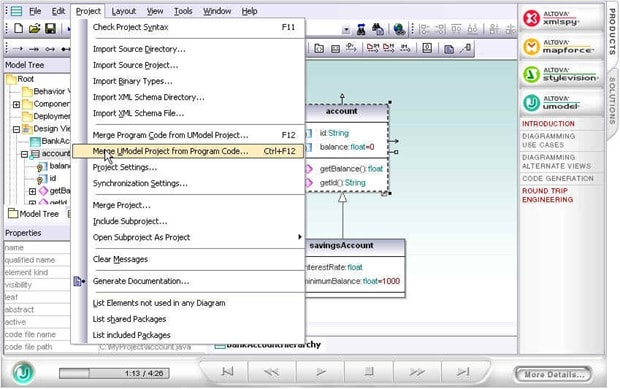 Even if you’re a code jockey who prefers to work directly in your IDE, maintaining an accurate UML model promotes good communication tool among team members. You can use the UModel UML project documentation feature to quickly generate customized project docs in HTML, rich text, or Microsoft Word formats that will keep the project manager happy too. And don’t forget, the UModel Enterprise Edition integrates with both the Visual Studio and Eclipse development environments and features automatic real-time synchronization of changes in either your source code library or UML model. We’re also thrilled with the popularity of the UModel video titled Creating UML Use Case Diagrams on both our site and YouTube. We posted it on YouTube just over a year ago, and it has accumulated over 18,000 views, becoming one of the most popular videos on YouTube covering the Unified Modeling Language. Please let us know what you think of the new Round Trip Engineering video, and stay tuned for upcoming installments on the DatabaseSpy database tool!
Even if you’re a code jockey who prefers to work directly in your IDE, maintaining an accurate UML model promotes good communication tool among team members. You can use the UModel UML project documentation feature to quickly generate customized project docs in HTML, rich text, or Microsoft Word formats that will keep the project manager happy too. And don’t forget, the UModel Enterprise Edition integrates with both the Visual Studio and Eclipse development environments and features automatic real-time synchronization of changes in either your source code library or UML model. We’re also thrilled with the popularity of the UModel video titled Creating UML Use Case Diagrams on both our site and YouTube. We posted it on YouTube just over a year ago, and it has accumulated over 18,000 views, becoming one of the most popular videos on YouTube covering the Unified Modeling Language. Please let us know what you think of the new Round Trip Engineering video, and stay tuned for upcoming installments on the DatabaseSpy database tool!
Altova to exhibit at Microsoft PDC next week
Integration Watch: Remember good tools at low cost?
Andrew Binstock, principal analyst at Pacific Data Works, recently published a great article in SD Times about some of the software tools he relies on to make his life easier. In “Integration Watch: Remember good tools at low cost?” he notes:
Read the complete article here and let us know what you think! What are some of the inexpensive software tools that you rely on?
Free Altova Online Training is Back!
Back by popular demand, Altova Online Training is now available in a brand new format. It’s still free – only now it’s offered in a convenient, self-service training model. Classes are available on-demand, and you no longer have to sign up or arrange your day around fixed class times. You can learn at your own pace, on your own schedule.
Each interactive training module contains guided instruction, tutorials, quizzes to test your learning, and resources for further study. You can complete each module in one sitting, or return to the class as often as you’d like to pick up where you left off.
The first new Altova Online Training class available is Introduction to MapForce, which is currently in BETA status.
During the BETA period, we’ll be relying on your feedback to help us improve future courses. Please share your comments and suggestions using the survey included in the Introduction to MapForce module, or post your comments on this blog.
We’re excited that Altova Online Training is back, and we hope you find it helpful for learning more about Altova tools and technologies!
Oracle OpenWorld 2008 recap
The Altova team exhibited at Oracle OpenWorld 2008 in San Francisco last week. The exhibit halls were packed, and we were happy to have a steady stream of visitors to our booth. We had the pleasure of talking with many Altova customers as well as other Oracle users and developers interested in Altova XML, database, and UML tools. Of particular interest with this crowd were MapForce and DatabaseSpy, but we talked with lots of folks whose challenges – from publishing XML and database data, to UML modeling, to Web services testing – could be met with other tools across the Altova product line. We also had the opportunity to introduce many visitors to the Altova MissionKit, and people were happy to hear that they could get a full suite of tools and save some money at the same time. Here are a few videos chronicling our trip, including some on-the-spot product demos. The first is a 1-minute bird’s eye tour of downtown San Francisco and the Altova booth in the Moscone West exhibition hall.
Here we learn how to efficiently migrate legacy relational data to a 21st-century XML application using XMLSpy. Bonus Scene: a water feature to improve your Feng Shui.
Finally, this video includes a demo of DatabaseSpy, featuring how to use the Graphical Database Design editor to explore and modify database tables. Bonus Scene: take a ride on a San Francisco cable car!
These were shot live on the floor of the exhibition, as you’ll hear from the enthusiastic crowds in the background, and at other spots around town. Whether you attended the show this year or not, we hope you’ll enjoy our video postcards. Altova’s next exhibit will be at Microsoft PDC in Las Vegas – we hope to see you there!
Diff / Merge Tools and Dog Food
Since its release in 2005, the Altova marketing team has been actively using the DiffDog diff / merge tool to compare and merge changes on our Web pages (something Product Marketing Manager David McGahey likes to call “eating our own dog food.” Get it? Dog food? Anyway…). We create and edit our content directly in XML using the XMLSpy XML editor and use WinCVS as our version control client. This way, we [not-so-technical marketing folks] can easily view and revert changes to any files in our CVS repository. When we need to compare changes made in two versions of a given file, we simply highlight the versions and launch DiffDog directly from WinCVS. It’s a lightning-fast way to see exactly what has been changed. Our Web Development team also makes good use of DiffDog’s directory comparison functionality to diff and merge between our test and live Web servers.
Our Web Development team also makes good use of DiffDog’s directory comparison functionality to diff and merge between our test and live Web servers.
Using DiffDog with Team Foundation Server
Jeff Levinson, Microsoft MVP and Application Lifecycle Management practice lead at Northwest Cadence, also recently shared his DiffDog story in an online article for Visual Studio Magazine, “Performing Comparisons with Team Foundation Server.” He details how you can replace the default merge tool in TFS with DiffDog. Do you have any stories to share about how you use our tools? Let us know!
Service Pack 2 Now Available
Just a quick note to let you know that Service Pack 2 of Altova Software Version 2008 Release 2 (2008r2 SP2) is now available… This service pack includes bug fixes and other enhancements and is a free update for all 2008r2 customers, as well as any customer with an active Altova Support and Maintenance Package. If you’ve not yet upgraded to v2008r2, check out all the new features or download a free trial.
Case Study: Equifax
Overview
Equifax is a leading credit reporting entity and provider of analytical and decision support tools. Their real-time authentication system, eIDverifier, offers government and businesses personalized online security measures that help protect them against fraud and comply with federal legislation. The eIDverifier process is used within e-commerce and other online applications to authenticate users’ identities based on their answers to personalized questions drawn from Equifax’s extensive data stores. The authentication process consists of five steps:
eIDverifier relies on the SOAP protocol to send messages defining these interactions back and forth between the client interface and the Equifax servers. Third party institutions license the eIDverifier SOAP interface for use within their online application processes, enabling them to integrate its functionality and access information contained in Equifax’s databases.Equifax uses the XMLSpy XML Schema editor to graphically design the XSDs that serve as the foundation for their SOAP interface.
The Challenge
Equifax needed a sophisticated tool for designing the XML Schemas that would define the data types for their Web service, as well as a mechanism for creating the WSDL documents that would describe the interface as a whole. As a Java shop, Equifax needed a solution that would be compatible with their other development tools, and that would work seamlessly with the Eclipse IDE. Though there are plenty of Java tools available that have the capacity for XML Schema development, XMLSpy presented the most attractive option for schema design because of its comprehensive graphical design and editing options.The Equifax development team took a further step to simplify their Web services creation, using XML Beans and the Codehaus XFire/CXF Java SOAP framework to auto-generate WSDL from their XML Schemas.
The Solution
eIDverifier relies on a variety of different technologies to bring identity verification and authentication to its clients. XMLSpy provides the following benefits:XML Schema
WSDL
The Results
The eIDverifier SOAP interface allows external applications to access Equifax’s backend data stores, exposing it as a Web service and enabling them to retrieve secure information without jeopardizing the integrity of the Equifax mainframe. Utilizing WSDL and SOAP, and surrounded by Java architecture, eIDverifier is able to confirm user identity by returning a set of multiple choice questions based on the secure data maintained by Equifax. XMLSpy enabled the Equifax team to quickly and easily create a graphical schema representation and the matching documentation to serve as the basis for the Web service. It also allowed the development team to focus on their Java code, rather than the intricacies of XML Schema and WSDL design. The Altova MissionKit provides numerous tools for advanced Web services development, from the graphical XML Schema and WSDL editing discussed here, to SOAP debugging, and even graphical Web services generation and data mapping. Download a free trial to check it out for yourself.
XMLSpy enabled the Equifax team to quickly and easily create a graphical schema representation and the matching documentation to serve as the basis for the Web service. It also allowed the development team to focus on their Java code, rather than the intricacies of XML Schema and WSDL design. The Altova MissionKit provides numerous tools for advanced Web services development, from the graphical XML Schema and WSDL editing discussed here, to SOAP debugging, and even graphical Web services generation and data mapping. Download a free trial to check it out for yourself.
Editing Database Views and Stored Procedures
“Ninety percent of the time you just need to make a simple modification,” the Redmond Magazine reviewer wrote in the introduction to the recent review that selected DatabaseSpy as Redmond Roundup Champion among database tools. DatabaseSpy lets you make those quick updates with its intuitive interface that is consistent across multiple database types. For the other ten percent of the time, DatabaseSpy can also be an appropriate tool for more advanced database maintenance tasks, such as creating or altering database views and stored procedures. Let’s take a look . . . The DatabaseSpy 2008 Online Browser lets you explore views and procedures by navigating and expanding them the same way you can explore tables in the hierarchical display of the Online Browser helper window.
Edit Database Views
When you select an existing database view in the Online Browser window, the right-click context menu offers options to generate new statements in the SQL Editor that can quickly get you started editing a view, or to assist creating a new one. For instance, when you generate a create statement for an existing view, DatabaseSpy displays the formatted and color-coded view definition for immediate access in a new SQL Editor window.
For instance, when you generate a create statement for an existing view, DatabaseSpy displays the formatted and color-coded view definition for immediate access in a new SQL Editor window. 
Create a New Database View
You can modify the statement any way you like in the SQL Editor. As an example, let’s assume you’ve been assigned to create a company phone directory view. All the data you need is already contained in the employees view – plus a lot more! You can start by saving a copy of the employee view with a new name. Simply edit the database view name, execute your statement, and the new database view is created. As you refresh the database connection in the Online Browser window, the new view is immediately visible and available for access.
As you refresh the database connection in the Online Browser window, the new view is immediately visible and available for access. 
Alter a Database View
You can choose the Alter selection from the right-click context menu to edit any database view, including the new phone directory view. You can revise the existing view to make the changes you want, taking advantage of all the DatabaseSpy SQL Editor functionality, including color coding, automatic formatting, and even auto-completion. When your edits are complete, the SQL Editor Execute button runs the alter statement and modifies the view in the database.
When your edits are complete, the SQL Editor Execute button runs the alter statement and modifies the view in the database.  To make access to the new phone directory view even easier for the HR department, you can save a select statement for the view in a SQL file and add it to the HR manager’s DatabaseSpy Project menu.
To make access to the new phone directory view even easier for the HR department, you can save a select statement for the view in a SQL file and add it to the HR manager’s DatabaseSpy Project menu. 
Use SQL Refactoring to Create a View
If you don’t have an existing view to use as a template, DatabaseSpy 2008 offers a convenient alternative. The SQL Refactoring menu includes an option to convert any select query to a create view statement. The default view name is even highlighted so you can immediately assign a more relevant name.

Edit Stored Procedures
The DatabaseSpy 2008 Online Browser also lets you edit stored procedures in your database. You can highlight any stored procedure, then can expand your selection to explore it. Or, use the right-click context menu to generate SQL statements for operations available to act on stored procedures.


You can edit stored procedures in the DatabaseSpy SQL Editor, and execute your revised statements using the same techniques described above for database views.
Execute Stored Procedures
The Execute option in the DatabaseSpy 2008 context menu for stored procedures builds a time-saving template for an execution script for the stored procedure.

For procedures that require parameters, all you have to do is set the parameter values, then it’s just one click to execute the stored procedure and view the results.
Edit User-defined Functions
DatabaseSpy 2008 even lets you navigate and edit user-defined functions stored in your database, starting from the same convenient right-click context menu in the Online Browser. Try this for yourself with a free trial of Altova DatabaseSpy.
Try this for yourself with a free trial of Altova DatabaseSpy.
Case Study: Wrycan, Fitz & Floyd, MarketLive
The Challenge
Fitz and Floyd required a solution that would automatically synchronize data from their Oracle database to MarketLive’s storefront application. It needed to perform the following functions: inventory updates, product updates, and order status updates. This way, when a customer ordered a Fitz and Floyd product via the MarketLive interface, they would be getting real-time information about the company’s inventory. The solution needed to be simple to use, easy to maintain, cost effective, and completed on time, so they could put their new storefront into production promptly. Fitz and Floyd’s existing data was housed in an Oracle 8.0.5 database and was organized according to internal requirements. In order to transform their data into a format that would work with MarketLive’s storefront application, Fitz and Floyd’s data needed to be mapped to MarketLive’s XML Schema. In addition, there needed to be a system in place to track and log any transaction errors that occurred.
The Solution
Because of MapForce’s ease-of-use, the Principal Consultant was able to get started using its intuitive features right away. Wrycan used MapForce to map the transformation from Fitz and Floyd’s Oracle database to the XML Schema definition (XSD) instance provided by MarketLive. Using the database as the source component and the XSD as the target, the following mapping was produced: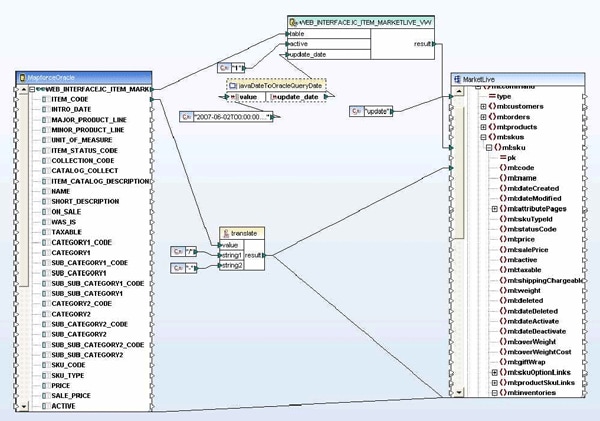
 In order to map to some XML Schema entities that were not explicitly defined in the original MarketLive schema, Wrycan used Altova XMLSpy’s graphical XML Schema editor to fill in the gaps, adding attributes to the schema that had not previously existed and thus ensuring that all necessary Fitz and Floyd data would be mapped to the MarketLive Web interface. An example of the schema modifications is shown below:
In order to map to some XML Schema entities that were not explicitly defined in the original MarketLive schema, Wrycan used Altova XMLSpy’s graphical XML Schema editor to fill in the gaps, adding attributes to the schema that had not previously existed and thus ensuring that all necessary Fitz and Floyd data would be mapped to the MarketLive Web interface. An example of the schema modifications is shown below: 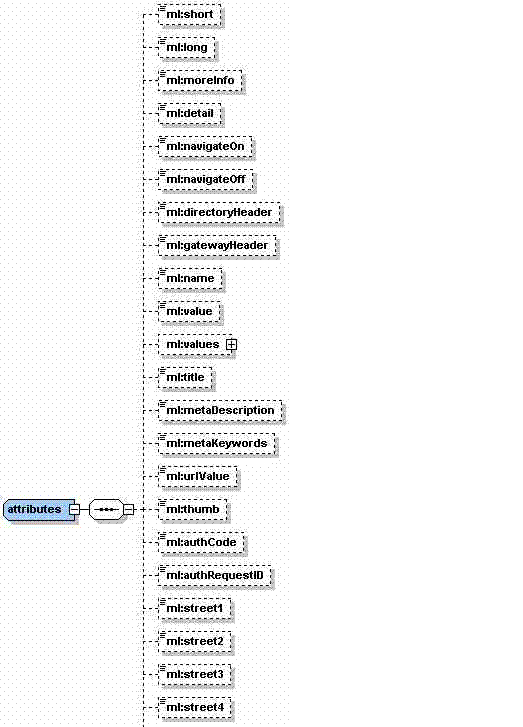 Wrycan used MapForce’s unique code generation capabilities to automatically produce a Java applet that was used to update Fitz and Floyd’s product, inventory, shipping, and order status information programmatically. This specialized applet was then packaged along with Wrycan’s proprietary Transaction Manager. MapForce made it very easy to update and redeploy the data mapping requirements as they changed throughout the project. Because of MapForce’s ease of use and built-in code-generation capabilities, less technical users can also update the data mapping when there are changes.
Wrycan used MapForce’s unique code generation capabilities to automatically produce a Java applet that was used to update Fitz and Floyd’s product, inventory, shipping, and order status information programmatically. This specialized applet was then packaged along with Wrycan’s proprietary Transaction Manager. MapForce made it very easy to update and redeploy the data mapping requirements as they changed throughout the project. Because of MapForce’s ease of use and built-in code-generation capabilities, less technical users can also update the data mapping when there are changes.
Simple Web-based Transaction Manager
Utilizing open source Java technologies such as Apache Tomcat and Quartz Enterprise Job Scheduler, Wrycan was able to create a simple transaction manager that allowed the transactions handled by the MapForce-generated, Java-based data integration applet to be scheduled, processed, and logged. The Transaction Manager is a custom software application made specifically for Fitz and Floyd by Wrycan, but built in such a way that it can be reused for future clients. It consists of several components:
The Transaction Manager’s user interface is the point of contact for Fitz and Floyd to control and schedule any data transformations. Because Wrycan wanted to be able to reuse the Transaction Manager, they chose to generate the MapForce code in Java, a platform-independent programming language. (MapForce can also generate application source code in C# and C++.) This code is an integral part of the Transaction Manager, as it dictates the data mapping process, allowing Fitz and Floyd’s internal information to be accessed via the MarketLive interface. The FTP interface is a simple way to manage the transfer and delivery of files from within the Transaction Manager once the MapForce-generated Java applet has transformed the data according to the MarketLive schema. A built-in batch scheduler allows Fitz and Floyd to automate the data migration operations by content type (i.e. order, inventory, product, etc.).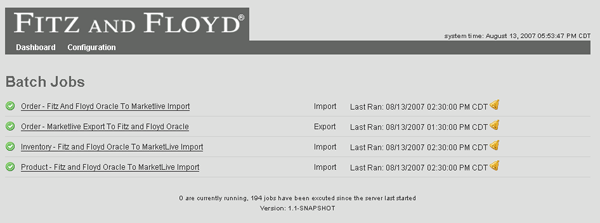 The reporting component allows the result of each transaction to be logged in XML. Because of this, if any transaction errors occurred, Wrycan was able to use Altova XMLSpy to analyze and debug the issues.
The reporting component allows the result of each transaction to be logged in XML. Because of this, if any transaction errors occurred, Wrycan was able to use Altova XMLSpy to analyze and debug the issues.
The Results
Fitz and Floyd now has an easy to use data integration layer that is extensible by adding new MapForce transformations, and they can easily adjust their current transactions. Any updates made to the Fitz and Floyd Oracle database are automatically transferred to the MarketLive application in a format that it can readily understand.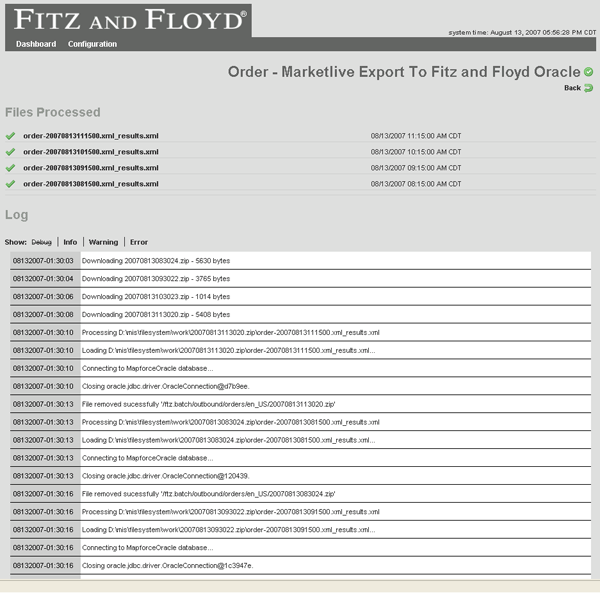 Because the Transaction Manager application is based on platform-independent Java code (generated by MapForce), Wrycan also has a reusable application that can be used as an asset by any online retail company. Wrycan is now able to approach potential clients with a proven data integration layer product that provides job scheduling, email notification, and FTP integration and can utilize any database or schema output via a custom Altova MapForce transformation. When speaking about this project, Dan Ochs, the principal consultant at Wrycan involved with the Fitz and Floyd application stated “MapForce has proven to be an easy-to-use, effective tool for making the data integration and mapping process much easier and faster to implement.” This and many other customer case studies involving Altova solutions are available in the Altova library.
Because the Transaction Manager application is based on platform-independent Java code (generated by MapForce), Wrycan also has a reusable application that can be used as an asset by any online retail company. Wrycan is now able to approach potential clients with a proven data integration layer product that provides job scheduling, email notification, and FTP integration and can utilize any database or schema output via a custom Altova MapForce transformation. When speaking about this project, Dan Ochs, the principal consultant at Wrycan involved with the Fitz and Floyd application stated “MapForce has proven to be an easy-to-use, effective tool for making the data integration and mapping process much easier and faster to implement.” This and many other customer case studies involving Altova solutions are available in the Altova library.
Redmond Roundup: Tooling Around in Your Database
RedmondMag.com just published a great article by Peter Varhol, a principal at Technology Strategy Research LLC, an industry analysis and consulting firm. This “Redmond Roundup” discusses common database management tasks and reviews some of the tools that are popular in that space:
Varhol examines three leading database tools and concludes by awarding Altova’s very own DatabaseSpy Redmond Roundup Champion, noting, “DatabaseSpy is the best overall in terms of range of features.”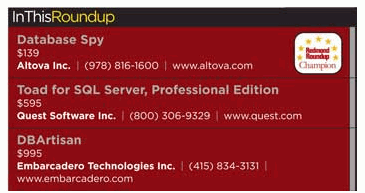 Image source: http://redmondmag.com/features/article.asp?editorialsid=2530
Image source: http://redmondmag.com/features/article.asp?editorialsid=2530
How to Recommend Improvements or New Features
The most valuable input the Altova team receives is from our customers and potential customers. This feedback shapes our future development plans for improving our tools and adding new features and functionality. We receive this feedback in multiple ways: by interacting with users at industry events, through comments on this blog, through customer case studies, and, most often, through Altova’s Online Support Center. You can use the Support Center to report a problem you’re having, get help with licensing questions, request new features, and more. The form will guide you to the right place to enter your request. As always, we look forward to hearing your feedback!
StyleVision Review on Blogcritics Online Magazine
Check out the review that T. Michael Testi just posted on Blogcritics.org — it has excellent information about and screenshots of Altova StyleVision. Testi has a long list of other software and book reviews if you’re interested in reading more.
Agile Modeling with UModel
Agile development is quickly becoming a leading model in the forward-thinking software community. The agile method seeks to bring development out of the document-heavy rigidity that exists within architecture-centric projects with a flexible and lightweight alternative that focuses heavily on adaptivity and customer communication. The agile model seeks to reduce the vast amounts of paperwork and planning put into many software development projects, shifting the focus to adapt to changing requirements and overall customer satisfaction. The Unified Modeling Language™ (UML®) has long been the de facto industry standard for object oriented software modeling, offering thirteen diagram types to represent three different system views: structure, behavior, and interaction. Altova’s UML modeling tool, UModel, presents an approach to UML that is both iterative and flexible, giving software documentation the ability to adapt and change with each new iteration, and offering customer-facing development teams the opportunity to present compelling application model designs every step of the way.
UML
Adopted as a standard by the Object Management Group (OMG) in 1997, and later formalized as ISO 19805, UML is actually the product of several different prevalent OO modeling languages which emerged in the early 1990s. UML is a graphical language for organizing, analyzing, and planning object-oriented or component-based software projects. The UML 2.1 specification defines thirteen major different diagram types and over one thousand graphical and textual language elements, as well as additional extension mechanisms. Traditionally these diagrams have been used by software developers and project managers as a powerful, standardized planning language to verify application logic and confirm that end-user needs will be met. UML is complex by design, offering a multitude of options for visually detailing software implementations in a wide variety of hierarchical models that can provide representations for every stage and process within the development cycle. Structure Diagrams
Behavior Diagrams
Interaction Diagrams
With this complexity comes a learning curve that can be easily addressed by choosing an intuitive UML modeling tool that includes advanced usability features and seamless graphical representations, as well as the agility to adapt and grow with a software development project. The Agile Manifesto Drafted in early 2001, the Agile Manifesto documents a set of principles for a faster, lighter, and goal-oriented approach to software development that contrast with the traditional waterfall method that has long existed at a majority of technology companies. The ideas behind agile development had been gaining notoriety over many years with the creation of other similar lightweight methodologies, many of which have since been incorporated into the agile family. The manifesto is built on the concept of software development as an iterative process that must be able to quickly adapt to ever-changing requirements and customer needs. The document focuses on:
An adherence to these overall goals intends to keep software projects limber and malleable enough to adapt to changing requirements, while keeping developers focused on the quality of their work at every stage of the process. Agile Modeling The agile methodology requires a modeling and documentation process that reflects the fluidity of its founding principles. The agile modeling process is a means to support development projects, addressing interaction and collaboration through the presentation of action plans in a visual format that stakeholders can readily understand, while also being technical enough to provide developers with a basis for their design. Agile modeling focuses on simplicity and the ability to process and handle changing requirements, leading to an incremental approach, where software projects are visually modeled and presented in phases, rather than a traditional model in which all encompassing plans are drawn up at the outset. The Agile Model Driven Development (AMDD) approach dictates a relatively short requirements analysis phase, with successive just-in-time modeling to address project needs at each iteration. Using this method, working software is available for review and testing at a much earlier stage, giving collaborators the opportunity to change requirements as the project evolves. UML and Agile Modeling The widespread adoption of UML as a modeling language stems largely from its ability to express software design in many different ways and at many different stages. In addition, its rapid acceptance as a standard suggests a recognized need for a unified approach to modeling, helping disparate development communities to collaborate over shared projects. As a predecessor to agile methods, UML was developed to address more stringent object-oriented design methods, which have more robust modeling and documentation requirements. However, with the right tool, developers, project managers, and stakeholders can take advantage of this standard modeling language in their agile projects. Agile Modeling with UModel Altova UModel is a full featured UML development tool, supporting all diagram types with additional support for code and documentation generation, reverse engineering, and advanced usability features. Fully compliant with the latest UML specification (2.1.1), UModel is a valuable asset to any form of software development. UModel’s unparalleled flexibility and functionality make it the ideal UML tool for agile modeling, allowing developers and collaborators to take advantage of the trusted UML standard by applying its modeling capabilities to agile methods.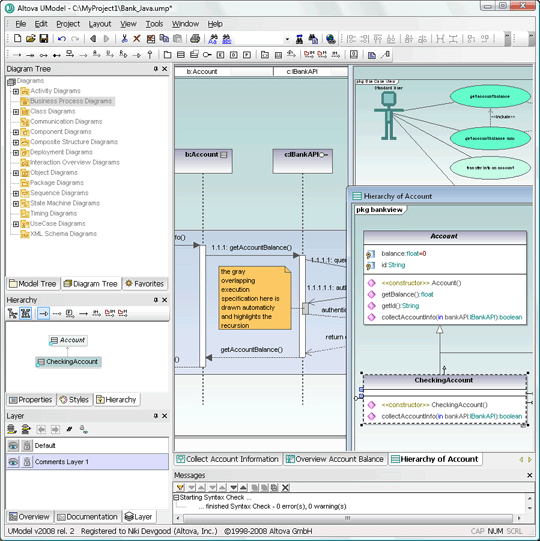 UModel offers advanced usability features that help lessen the UML learning curve, making modeling accessible to all project collaborators. With a focus on versatility in model design, UModel offers a completely customizable interface with color-coded elements to clearly indicate model characteristics.
UModel offers advanced usability features that help lessen the UML learning curve, making modeling accessible to all project collaborators. With a focus on versatility in model design, UModel offers a completely customizable interface with color-coded elements to clearly indicate model characteristics. 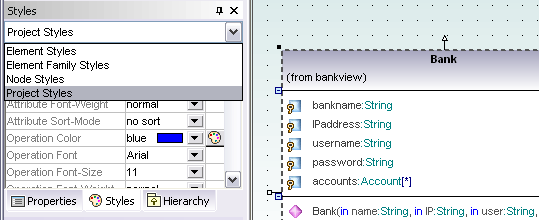 Users can also add additional customizations to enhance usability and communication that can be automatically applied to single elements, groups, or project-wide. UModel’s rich visual interface enables developers to quickly and easily sketch software designs to communicate all aspects of system architecture. This lightweight approach to UML design melds perfectly with the agile methodology, opening avenues for communication over dynamic project representations. UModel provides additional support for collaboration through support for shared packages, which enable developers to distribute their functional designs to other team members or import designs from other projects for reuse.
Users can also add additional customizations to enhance usability and communication that can be automatically applied to single elements, groups, or project-wide. UModel’s rich visual interface enables developers to quickly and easily sketch software designs to communicate all aspects of system architecture. This lightweight approach to UML design melds perfectly with the agile methodology, opening avenues for communication over dynamic project representations. UModel provides additional support for collaboration through support for shared packages, which enable developers to distribute their functional designs to other team members or import designs from other projects for reuse. 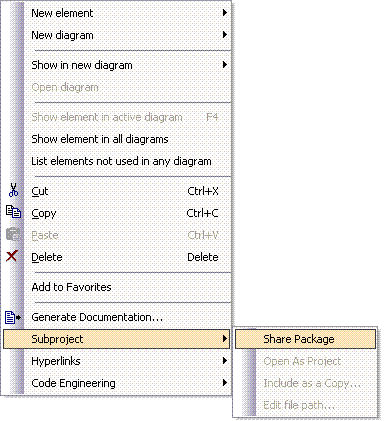 Visual design representations can also easily be saved or printed as images for conceptual review by non-technical contributors.
Visual design representations can also easily be saved or printed as images for conceptual review by non-technical contributors. 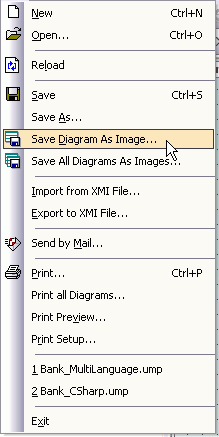 Another compelling feature in UModel that drives inter-project communication as well as customer collaboration is the ease at which developers can create informative use case diagrams. UML use case diagrams tend to be a popular choice in agile modeling because they address one of the most challenging phases of the software development process, the visualization of user interaction. UModel use case diagram representations can be seamlessly illustrated with the help of advanced usability features and sophisticated graphical output.
Another compelling feature in UModel that drives inter-project communication as well as customer collaboration is the ease at which developers can create informative use case diagrams. UML use case diagrams tend to be a popular choice in agile modeling because they address one of the most challenging phases of the software development process, the visualization of user interaction. UModel use case diagram representations can be seamlessly illustrated with the help of advanced usability features and sophisticated graphical output. 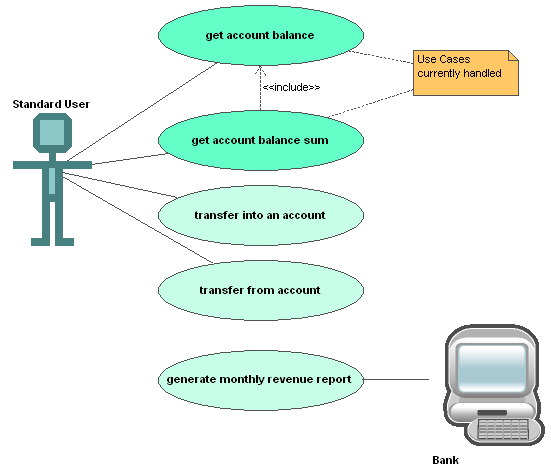 UModel also allows developers to auto-generate detailed documentation, including embedded images, in HTML, RTF, or Microsoft® Word. This feature addresses the second point of the Agile Manifesto, enabling teams to focus their efforts on software design, rather than getting buried in overbearing documentation that can sometimes stall project flow.
UModel also allows developers to auto-generate detailed documentation, including embedded images, in HTML, RTF, or Microsoft® Word. This feature addresses the second point of the Agile Manifesto, enabling teams to focus their efforts on software design, rather than getting buried in overbearing documentation that can sometimes stall project flow. 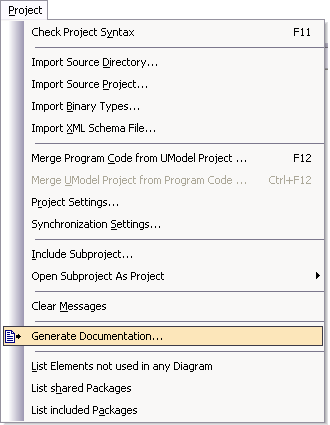 UModel’s robust round-trip engineering capabilities provide agile developers with the ability to quickly adapt and respond to change over the course of their project(s). UModel interprets modifications to project source code and synchronizes this with the corresponding UML diagram. UModel supports Java, C#, and Visual Basic, bringing advanced functionality and flexibility to the iterative development process.
UModel’s robust round-trip engineering capabilities provide agile developers with the ability to quickly adapt and respond to change over the course of their project(s). UModel interprets modifications to project source code and synchronizes this with the corresponding UML diagram. UModel supports Java, C#, and Visual Basic, bringing advanced functionality and flexibility to the iterative development process. 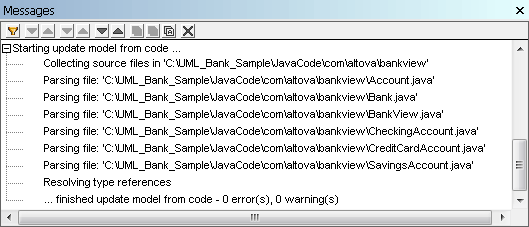 UModel also offers tight integration with the leading integrated development environments, Visual Studio® and Eclipse, giving developers the ability to seamlessly switch between the UML model and code editing windows and see any updates and changes reflected in real-time. UModel’s extensive usability and communication features offers development teams the ability to quickly change and adapt project requirements based on the results of incremental collaboration. Its graphical design interface and intuitive modeling capabilities enable team members to create compelling visual designs that can be easily interpreted by both technical and non-technical stakeholders at every stage of the project. Conclusion The wide acceptance of agile practices signifies a shift from the role-based, waterfall approach that was the norm just a few years ago. Businesses are recognizing that software projects are constantly changing and evolving at every step of the way. Development teams need to be able to manage change, to meet deadlines, and to lower costs. Nothing is quite as effective as the right set of concise diagrams to represent the essence of a software implementation. UML has the capacity to deliver structure to vague and abstract customer requirements, enabling developers to easily conceptualize the task at hand. With its flexible and advanced UML design interface, UModel is an ideal modeling tool for agile development, giving developers an inexpensive, easy-to-use, comprehensive modeling option with robust features for project collaboration and communication. UModel gives users the opportunity to capitalize on the extensive capabilities of the UML standard, but also offers the plasticity required of agile implementations. You can try UModel for free in your next agile development project. This technical brief and other resources are available in the Altova Library.
UModel also offers tight integration with the leading integrated development environments, Visual Studio® and Eclipse, giving developers the ability to seamlessly switch between the UML model and code editing windows and see any updates and changes reflected in real-time. UModel’s extensive usability and communication features offers development teams the ability to quickly change and adapt project requirements based on the results of incremental collaboration. Its graphical design interface and intuitive modeling capabilities enable team members to create compelling visual designs that can be easily interpreted by both technical and non-technical stakeholders at every stage of the project. Conclusion The wide acceptance of agile practices signifies a shift from the role-based, waterfall approach that was the norm just a few years ago. Businesses are recognizing that software projects are constantly changing and evolving at every step of the way. Development teams need to be able to manage change, to meet deadlines, and to lower costs. Nothing is quite as effective as the right set of concise diagrams to represent the essence of a software implementation. UML has the capacity to deliver structure to vague and abstract customer requirements, enabling developers to easily conceptualize the task at hand. With its flexible and advanced UML design interface, UModel is an ideal modeling tool for agile development, giving developers an inexpensive, easy-to-use, comprehensive modeling option with robust features for project collaboration and communication. UModel gives users the opportunity to capitalize on the extensive capabilities of the UML standard, but also offers the plasticity required of agile implementations. You can try UModel for free in your next agile development project. This technical brief and other resources are available in the Altova Library.
Altova UModel adds Business Process Modeling, Layers, Java 6.0, C# 3.0, and VB 9.0, plus much more in v2008r2
The Altova UML tool for software modeling and application development keeps getting better and better, with recently launched UModel Version 2008 Release 2 adding exciting new features including support for business process diagrams in BPMN notation, code engineering support for Java 6.0, C# 3.0, and Visual Basic 9.0, diagram layers, enhanced auto-completion, and much more. We can’t wait to see how users take advantage of the new layers feature: In UModel 2008 Release 2 you can assign each diagram element to a specific layer and set each layer to be hidden or visible. Just imagine how you could take advantage of layers to build simplified views within complex activity diagrams, state machine diagrams that contain superstates and substates, to identify the roles of different parties in business process diagrams, or in virtually any UML diagram that grows to more than two dozen or so elements!
In UModel 2008 Release 2 you can assign each diagram element to a specific layer and set each layer to be hidden or visible. Just imagine how you could take advantage of layers to build simplified views within complex activity diagrams, state machine diagrams that contain superstates and substates, to identify the roles of different parties in business process diagrams, or in virtually any UML diagram that grows to more than two dozen or so elements!
Technical Brief: Streamlining Localization Processes with Altova Tools
Rapid globalization has had a profound effect on the documentation requirements of many forward-thinking companies. The need to quickly and accurately localize content for distribution to a host of different languages, while at the same time adhering to strict budgetary requirements, means that many companies have to rethink their legacy documentation technologies and workflows. XML and single source publishing have revolutionized content management, document exchange, and multilingual communications by separating content structure from appearance. An XML-based documentation system can greatly reduce costs through facilitating ease of conversion for delivery to many different data formats and types of applications. However, in order to take advantage of the full benefits XML provides, changes must be made in the traditional documentation workflow process. Throughout the documentation workflow, checks and balances are underway to ensure high quality content delivery. The single source concept ensures that these processes (i.e. conversion, edits, etc.) do not have to be repeated or reworked – that all content in the repository requires only minimal restructuring and promotion before being loaded to respective applications for delivery. In a global setting, where documentation needs to be simultaneously distributed to a variety of different languages, archival XML source documents can easily be translated by applying translation scripts as well as rendering scripts that can localize formatting attributes based on language-specific requirements. In addition, translation and maintenance costs can be significantly reduced by normalizing content for an international market.
XML Documentation
XML has long been lauded by the publishing industry as a cost-cutting solution to many process-related issues in content production and delivery. Having content converted to XML allows for enhancements in content organization, indexing, linking, storage, reuse and delivery/display. But just having content converted to XML does not allow it to reach its full benefit. XML and its associated technologies call for redesigned workflows to demonstrate their enormous potential. An optimized workflow for content publishers requires minimal process repetition. Once content is delivered, it is edited and converted to XML and stored in a centralized single source repository within the content management architecture. The XML files themselves will be minimally defined (tagged) so as to allow maximum flexibility. This repository now becomes the core storage mechanism for all deliverable content. It is on the delivery side that this process model demonstrates its primary benefits. Storing content in the single source repository transforms exporting the content to different formats and applications for delivery into a primarily automated process. There is no need for additional conversions or edits each time content is to be delivered to a different medium. In addition, any complications that arise will now be instantly recognized as process-oriented rather than data-oriented.
Translation
Legacy translation memory databases attempt to modularize content by segmenting source and translated text and storing it in a searchable database for reuse. Though these partially automated systems have been proven to reduce costs when compared to manual processes, the fact that translation is generally done at the sentence level means that is often taken out of context and therefore often loses its meaning. XML documents, on the other hand, are inherently modular and do not require the extensive parsing applied by traditional translation memory systems. In addition, XML assets can easily be encoded (with metadata, for example) and tracked throughout the translation process, ensuring that it remains closely associated with the contextual information often required by translators. An XML-enabled single source publishing model is designed to leverage content reuse, enabling organizations to save significant time and money through reducing or even eliminating repeated translations. XML gives publishers the ability to conceptually segment content assets for translation purposes, while at the same time keeping them closely tied to context. In the case of document frameworks, such as technical publishing, where text is often repeated in many different places, the ability to consolidate resources offers potentially enormous savings in translation costs alone.
Standards
A growing number of emerging standards are designed to aid in the localization of document frameworks. Methodologies for translation workflows and document exchange are designed to streamline content management architectures for multilingual environments. These include:
The extensible nature of XML lends itself to the creation of a wide variety of industry specifications, many of which enable businesses to streamline business processes and improving communication.
Formatting
In today’s global marketplace, organizations are often challenged with having to produce content in a variety of different languages. In a traditional documentation workflow model, this is an extremely arduous process. Legacy publishing software such as Quark, PageMaker, FrameMaker, etc. require expensive and resource-intensive desktop publishing and engineering processes for repurposing. In addition, these page layout applications are generally not well suited for delivery to multiple output formats. XML is inherently extensible, offering an infinite number of ways to define and structure markup. This flexibility also enables it to handle arbitrary data structures and convey information for both human users and machines for processing. In addition, XML also provides broad support for Unicode characters, enabling the automation of text normalization processes and making it natively accessible to multilingual environments. An XML documentation framework offers significant productivity enhancements to the localization workflow. The separation of content from structure and appearance that is inherent to XML gives companies the ability to translate text while at the same time maintaining the document structure dictated by an XML Schema or DTD. Any additional formatting that is required can also be simultaneously implemented through the application of XSLT and/or XSL:FO stylesheets.
Altova Tools for XML-based Single Source Publishing in a Global Environment
There are, of course, several different methods for internationalizing content with XML technologies. Included below are just a few of examples of how Altova tools can be used to streamline global publishing workflows. Multiple Output Formats Language-specific Stylesheets
Language-specific Stylesheets  Of course, this approach to multi-lingual publishing can lead to the creation of an enormous number of stylesheets that are increasingly difficult to maintain. SchemaAgent, Altova’s XML-based file management system offers advanced support for managing XSLT (as well as XML Schema and WSDL) document relationships in a large publishing environment.
Of course, this approach to multi-lingual publishing can lead to the creation of an enormous number of stylesheets that are increasingly difficult to maintain. SchemaAgent, Altova’s XML-based file management system offers advanced support for managing XSLT (as well as XML Schema and WSDL) document relationships in a large publishing environment.  XSL Lang() Function
XSL Lang() Function  WYSIWYG Authoring Tool
WYSIWYG Authoring Tool  Authentic also includes a multi-lingual spell-checker that references built-in dictionaries in 18 different languages and vocabularies, allowing writers and translators to ensure the accuracy of their work.
Authentic also includes a multi-lingual spell-checker that references built-in dictionaries in 18 different languages and vocabularies, allowing writers and translators to ensure the accuracy of their work. 
StyleVision is a graphical stylesheet design tool that enables users to create one design for simultaneous output to HTML, RTF, PDF, Word 2007 (OOXML), and Authentic electronic forms.
StyleVision also supports user-defined parameters that allow designers to maintain the modularity of their XML assets through the application of variables. This enables publishers to add unlimited new languages to their documentation by importing language-specific stylesheets and leaving XML content untouched.
StyleVision also supports the XSL lang() function, which pulls the correct translation from XML source document(s) based on the xml:lang attribute. In this scenario, the translations could be stored together in one XML instance as specified in the xml:tm standard, or stored separately in language-specific directories.
Authentic gives content contributors the opportunity to edit XML directly through e-Forms based on the stylesheet design created in StyleVision. Authentic is available through a free license so that it can be deployed to an unlimited amount of users without increasing costs. This enables translators to work directly with XML, rather than having it transposed at a later date for publishing.
Conclusion
Single source publishing calls for the creation of a centralized store of content that can be accessed, reused, and deployed to a variety of different mediums. This enables the integrity of the content to be maintained throughout an infinite number of iterations. In a large documentation localization pool, the ability to adapt to different language and formatting requirements provides significant business advantages. There are several different approaches to maintaining single source content for a global audience. A careful and informed approach to preparing and storing content assets can ensure a variety of benefits including increased quality and consistency, reduction of translation costs, and increased longevity of translation investments. In addition, the XML-enabled single source publishing model facilitates document repurposing for delivery to a variety of different formats, making it accessible to end-users in HTML, RTF, PDF, Word 2007 (OOXML), etc. Incorporating this system within organizations documentation workflow processes enables the presentation accurate, consistent, and standardized information. XSL transformations apply format-specific processing instructions while ensuring that document content and structure remain intact. Migrating content to XML-based single source publication workflows requires some initial planning and technology investment, but the rewards are numerous. Cost reductions in translation and type-setting, faster time-to-market, and the ability to adapt to new language and data structures requirements in the future make the relatively small investment worthwhile. Discover how single source publishing can optimize your global documentation workflows with a free trial of StyleVision. Please note that StyleVision and the other products mentioned above are available as part of Altova’s software bundle, MissionKit, which offers XML and data management tools for distributed publishing environments. This technical brief and other resources are available in the Altova Library.
Service Pack 1 of Altova Software Version 2008 Release 2 is Available
Today we released Service Pack 1 (SP1) of our complete Version 2008 Release 2 product line. SP1 contains helpful bug fixes and other useful enhancements and is a free update for all v2008r2 users. It’s also a free upgrade for any customers with an active Support and Maintenance Package. Simply visit the Altova download page to get the latest version or learn more about all the functionality added in R2.
Welcome to the Altova Blog!
Welcome to the new, official Altova Blog, where you’ll find information on Altova announcements, new product features, and events – as well as useful reference material such as whitepapers, technical case studies, technology tips, and more. If you subscribed to either of Altova’s RSS feeds in the past, these have been replaced by the blog feed. Rest assured: you’ll still be receiving the same information – it will just be in a more fun, easily digestible format and updated more frequently. If you’re just joining us now, you can subscribe via your preferred reader in the right-hand sidebar. You’ll see that the Altova team has already been busy posting entries – check them out for a taste of what’s to come. We look forward to creating interesting posts and reading your comments!
Altova at TechEd
Microsoft TechEd 2008 is presently underway in Orlando, FL, and this year the show has been split into two separate events: TechEd for Developers is coming to an end tomorrow, and next week we have TechEd for IT Professionals. Altova is sponsoring both events and we invite you to visit us at booth# 1114 to see the latest new features in version 2008r2 of our developer tools. We’ll be happy show you the new Open XML (OOXML) features introduced in MapForce, StyleVision, and DiffDog, as well as the new support for C# 3.0 and Visul Basic 9 in our UML modeling tool, UModel. To try these new features yourself, you can download a free 30-day eval version from our web site.
MapForce data mapping tool now supports Excel 2007/OOXML mapping
We’re excited to have recently announced the availability of Altova MapForce Version 2008 Release 2 (v2008r2). The latest update to the MapForce graphical data mapping tool provides powerful new functionality, including support for mapping Microsoft® Excel 2007, which uses the Office Open XML (OOXML) file format, integration with and project generation for Visual Studio® 2008, support for data streams in MapForce generated code, and much more.

Come visit us at Microsoft TechEd 2008 in Orlando this week and next at booth# 1114 and we’ll be happy to demo the new features to you.
Case Study: MapForce EDI Conversion Optimizes Business Transactions
National Frozen Foods Corporation, a family owned company, works with many vendors to get their products from the warehouse out to the market. Communications between the warehouse and vendors are sent via the X12 dialect of Electronic Data Interchange (EDI), a standard data format for business transactions.

The company had been using the EDI format for its B-2-B transactions, but relied on outside consultants to convert their internal flat file format (EIF) into EDI for processing. Such outsourcing proved to be expensive, often untimely, and introduced bugs, which then required additional development costs. Recognizing the need to create a more efficient documentation workflow that would cut costs and save time, National Frozen Foods decided to bring their EDI conversion in-house.
The solution they chose – Altova MapForce – is a visual data mapping and code generation tool that allows you to map and convert any combination of XML, database, flat file, EDI, Excel 2007, and/or Web services data formats.
With its built-in EDI support, flat file conversion, and code generation capabilities, along with its ease-of-use, MapForce helped National Frozen Foods successfully bring their EDI implementation in-house.
Using the MapForce FlexText module, NFF can directly parse the internal flat file format using a convenient graphical user interface:
The company can now maintain a codebase that can be easily modified and re-used for future transactions and thus eliminate their need for outsourcing.
For more information, access the full case study and more screenshots or download a free 30-day trial of Altova MapForce.
Creating Open XML (Excel 2007) Spreadsheet Documents
Altova CEO, Alexander Falk posted the following article on his XML Aficionado blog today on how to use MapForce to create Excel 2007 documents programmatically:
Altova at JavaOne
Altova exhibited at JavaOne 2008 this year, talking with attendees about their projects and challenges, and showing them demos of relevant features in the Altova product line. In particular, booth visitors were interested in learning about Altova’s support for Java code generation in multiple tools, as well as the new Microsoft® Office 2007 / Office Open XML (OOXML) support that was recently added across the product line. Here is a short video of Altova’s David McGahey doing a product demo in the Altova booth.
Several other videos from the Altova booth at JavaOne are available on YouTube.
Altova Delivers Release 2 of XMLSpy 2008 with Important New Features
Altova, (www.altova.com) creator of the industry-leading XMLSpy XML Editor and other leading XML, data management, UML, and Web services tools, recently announced the availability of Altova XMLSpy Version 2008 Release 2 (v2008r2). The latest release of XMLSpy provides many new enhancements to help users optimize their XML development processes, including support for very large files, multiple features for optimizing XSLT development, a new Find in Schemas window, and much more.

Producing Word 2007 (Open XML) from XML and database data
This article originally appeared on the XML Aficionado blog of Altova CEO, Alexander Falk.
The latest release 2008r2 of StyleVision gives users important new functionality for creating advanced stylesheets to publish XML and database data in Word 2007, which uses the new Open XML (OOXML) data format, as well as simpler processes for publishing the same source content in other formats. And, to further ease the transition for developers and designers working with OOXML, we have just reduced the price of StyleVision considerably. As adoption of Open XML increases, StyleVision developers will be ready with a powerful tool for publishing XML and database data in what is sure to be the most predominant end-user document format, now that Open XML has been approved as an ISO standard. Here is how the process works:
StyleVision can access data from database tables,views, or you can directly enter a SQL SELECT statement to query only for particular data from a database. This makes StyleVision ideal for flexible database reporting, too. If you are interested in further details, you can read more about the new features of StyleVision 2008r2 here.
Altova Adds Word 2007 (OOXML) Capabilities to its Graphical Stylesheet Design Tool and Cuts the Price to Ease Adoption
Altova, (www.altova.com) creator of the industry-leading XMLSpy XML Editor and other leading XML, data management, UML, and Web services tools, today announced the availability of Altova StyleVision Version 2008 Release 2 (v2008r2). The latest update to StyleVision provides users with numerous features and enhancements, including capabilities for generating output in Microsoft® Word 2007, which uses the Office Open XML (OOXML) file format, support for grouping functionality when designing XSLT 2.0 stylesheets, and much more – all at a significantly reduced price point compared to previous versions.

Altova Announces Version 2008 Release 2 of its Software Product Line
(Altova today announced the availability of Version 2008 Release 2 (v2008r2) of its award-winning line of software tools. The release of v2008r2 adds a host of new features and enhancements to Altova’s product line, including support for working with very large files in XMLSpy, extended Office Open XML (OOXML) functionality across multiple products, support for creating Business Process Modeling Notation (BPMN) diagrams in UModel, and much more.
Visit https://www.altova.com/whatsnew.html to view a complete list of new v2008r2 features with screenshots.
Very Large XML File Support – XMLSpy v2008r2 contains a number of advanced optimizations that allow you to open and work with files that are about 4 to 5 times larger than those supported in the past*, providing a huge benefit for working with large amounts of data in the context of database applications, financial services, data gathering, and enterprise data integration. This new support results in a reduction of memory-consumption by up to 75-80 percent as compared to the previous version when opening and validating XML documents in Text View.
In this latest release, XMLSpy v2008r2 also provides multiple features for optimizing XSLT development, including new entry helper windows and support for Java, C#, JavaScript, and VBScript in the XSLT 1.0/2.0 and XQuery engines. This enhanced functionality makes XMLSpy and AltovaXML(TM) the first universal XSLT engines to support all of these programming dialects.
In addition, XMLSpy’s support for seamless integration with and code generation for Visual Studio(R) has been extended in v2008r2 to include support for Visual Studio 2008.
Extended Microsoft(R) Office 2007 / OOXML functionality – With OOXML functionality already available in XMLSpy, Altova now expands that support across its MapForce(R), StyleVision(R), and DiffDog(R) products. MapForce supports the OOXML data format in Microsoft Excel(R) 2007. Now you can map Excel 2007 data to and from XML, databases, text, EDI, and Web services, and then convert data instantly or autogenerate royalty-free program code for recurrent transformations. As Microsoft customers continue to upgrade to the newest version of the Office suite, support for Excel 2007 will become an indispensable feature for sophisticated data integration projects and applications.
In StyleVision v2008r2, new OOXML support allows designers and developers to create stylesheets to publish XML and database data in Word 2007. StyleVision’s drag-and-drop stylesheet design interface simultaneously generates output in HTML, PDF, RTF, Word 2007, and Authentic(R) e-Forms, plus the corresponding XSLT stylesheets. Support for Word 2007 / OOXML in StyleVision will now enable you to design stylesheets for an even larger network of users as adoption of Office 2007 / OOXML continues.
In addition, Altova has reduced the price of StyleVision considerably to further ease the transition for developers working with the new OOXML formats.
For DiffDog v2008r2 users, detailed differences in Office 2007 / OOXML file pairs and other ZIP archive pairs are now displayed. You can perform extensive comparisons of OOXML files and ZIP archives, identify differences, and merge changes with more accuracy and efficiency than ever before.
Expanded Modeling Capabilities – UModel v2008r2 now supports the Business Process Modeling Notation (BPMN), allowing you to create BPMN diagrams to illustrate a business process prior to development.
UModel v2008r2 also includes updated code generation and reverse engineering support for Java 6.0, C# 3.0, and Visual Basic 9.0, including accurate parsing of new language constructs introduced in C# 3.0 and VB 9.0 that directly support XML. This added functionality makes UModel the first UML tool to support C# 3.0 and VB 9.0. These are just a few of the many compelling new features being introduced in UModel v2008r2.
Access to Global Resources – Direct access to global resources is now available within XMLSpy, MapForce, StyleVision, and DatabaseSpy(R), providing increased integration between these tools. This new functionality will be especially useful for customers with multiple Altova products, such as those using the Altova MissionKit(TM) product bundle.
Global resources support allows you to define, share, and access file, folder, and database resources across multiple projects and multiple software tools. This will allow MissionKit users to, for example, access and work with the output of a MapForce data mapping project — as it is produced on-the-fly — in XMLSpy and/or StyleVision. Countless other scenarios of tight integration between XMLSpy, MapForce, StyleVision, and DatabaseSpy are possible.
You will also now be able to define a target deployment environment on-the-fly within XMLSpy, MapForce, StyleVision, and DatabaseSpy projects, specifying ancillary files, directories, data sources, databases, etc. This means that a project can be thoroughly tested in multiple environments without having to be redesigned before it goes live. Support for global resources only adds to the numerous other productivity-enhancing features of the Altova MissionKit, which bundles up to eight Altova XML, data integration, and data management tools for less than the price of two.**
v2008r2 is a free update for Altova customers with an active Support and Maintenance Package. Visit https://www.altova.com/download.html to update now.
To download a 30-day free trial of any of the Altova products visit: https://www.altova.com/download.html
*Reduced memory-consumption of up to 75-80% measured in internal tests at Altova with XML files ranging from 10MB to 200MB in size, comparing XMLSpy 2008r2 with XMLSpy 2008sp1. Your results may differ.
**Pricing comparison is edition-specific and based on Altova MissionKit vs. any two individual licenses of the following included products: XMLSpy and MapForce.
Altova XMLSpy Earns Programmer’s Paradise Riding the Crest Award
Altova, (www.altova.com) creator of the industry-leading XMLSpy XML Editor and other leading XML, data management, UML, and Web services tools, today announced that Altova XMLSpy has received the 2007 Programmer’s Paradise Riding the Crest® Award in the XML Tools category. Programmer’s Paradise®, a subsidiary of Wayside Technology Group&tm;, Inc., is the leading independent marketer of software development and infrastructure tools for technology professionals, offering thousands of products that aid programmer efficiency. The Riding the Crest Awards, given annually, are determined by total sales in each category featuring at least three competitive products.
Using TrueType Fonts for StyleVision PDF Generation
StyleVision is Altova’s visual stylesheet designer for publishing XML and database data in PDF and other formats. Limitations in the design of the Apache FOP processor cause TrueType fonts to be unavailable for PDF generation. This tip for creating TrueType font metrics files, along with the downloadable scripts, provides StyleVision users with a workaround for this issue.
A metrics file is created by calling the Java application TTFReader. TTFReader is included with Apache FOP, so if you have Apache FOP installed, TTFReader is already installed, too.
If you are proficient in calling a Java application, you can call TTFReader yourself to create the metrics file for each TrueType font. Alternatively, we have provided a set of command files below that ease this task. With these command files, you can easily create metrics files for all the TrueType fonts installed on your computer.
Please visit https://www.altova.com/technote12.html to view the complete tip with screenshots and a link to download the command files.
If you’re not already a StyleVision user, you may download a free, 30-day trial here: https://www.altova.com/download.html
LANSA OEMs MapForce to Convert Data in Business Process Integration App
A recent article in Database Trends & Applications magazine highlights how MapForce, Altova’s graphical mapping, conversion, and integration tool is working behind the scenes for LANSA Composer to give non-technical users the power to perform business process automation tasks.
LANSA, a software company offering a development environment for application generation and integration on multiple computer systems, chose MapForce because it was the only candidate that met the project’s four most important criteria:
LANSA Composer uses the MapForce application as its transformation component. MapForce generates a platform-independent Java applet behind the scenes based on the user input from the mapping. While invisible to the LANSA Composer user, the code enables the business processing engine to execute the transformation component of the business process integration sequence.

Read the entire article, featured in the March issue of Database Trends & Applications magazine, as well as other recent reviews and news stories here: https://www.altova.com/news_and_reviews.html
Download a free 30-day trial of Altova MapForce at: https://www.altova.com/download.html to see how easy it can be to map between XML, database, EDI, flat file, and Web services data formats.
Altova Receives the ComponentSource Bestselling Publisher and Product Awards
Altova, (www.altova.com) creator of the industry-leading XMLSpy XML Editor and other leading XML, data management, UML, and Web services tools, today announced that Altova XMLSpy, and the Altova MissionKit received 2007 ComponentSource Bestselling Product Awards. Altova was also presented with the Top 25 Bestselling Publisher Award.
White Paper: Reaping the Benefits of pureXML with Altova Tools
The IBM® DB2® data server offers a scalable and reliable information infrastructure that provides seamless integration of XML and relational services. Now with the deep integration of Altova tools and DB2 9, users can query, exchange, transform, and edit their XML artifacts more quickly, easily, and accurately.
Demonstrated using an online brokerage scenario, this white paper shows how the integration of Altova tools with DB2 allows users to:
The solutions to the business problems presented in the white paper show how DBAs and developers working with real-world XML applications can benefit from the integration of Altova tools with IBM DB2 9.
Access the white paper here to read more about these solutions and view screenshots: https://www.altova.com/resources_wp.html#ibm_whitepaper
Get more information about using Altova tools when working with IBM DB2 9 pureXML here: https://www.altova.com/IBM_DB2_9_pureXML.html
Download a free 30-day trial of the Altova MissionKit here: https://www.altova.com/download.html, and see how working with XML-related technologies in DB2 9 is enabled by Altova tools.
Windows IT Pro Magazine Presents Altova XMLSpy with the “Best of Connections 2007” Award
Altova, (www.altova.com) creator of the industry-leading XMLSpy XML Editor and other leading XML, data management, UML, and Web services tools, today announced that Altova XMLSpy was named as winner of the “Best of Connections 2007″ in the Office category by Penton Media’s Windows IT Pro. In the award’s first year, the judges reviewed over 60 IT products and services submitted for the contest and chose 18 finalists that were evaluated at Microsoft Connections in Las Vegas. Interviews were conducted, and winners were announced on the exhibit floor of the Connections conference.
Altova XMLSpy Earns IBM CTO Innovation Award Certificate of Excellence
Altova, (www.altova.com) creator of the industry-leading XMLSpy XML Editor and other leading XML, data management, UML, and Web services tools, today announced that Altova XMLSpy received a 2007 IBM CTO Innovation Award Certificate of Excellence for its deep integration with the IBM DB2 9 data server. Altova XMLSpy provides users with exclusive functionality for querying, editing, transforming, and exchanging XML data stored in DB2 9 databases. The CTO Innovation Award Certificate was presented in conjunction with the second annual Information Management Business Partner Awards at the IBM Information on Demand conference held October 14-19 in Las Vegas, NV.
Altova Releases Version 2008 of its Award-winning Software Product Line
Altova, creator of XMLSpy and other leading XML, data management, UML, and Web services tools, today announced the availability of Version 2008 (v2008) of its award-winning line of software development tools. With the release of its v2008 products, Altova introduces a host of powerful new capabilities, including support for the Widows Vista operating system across the product line, extended support for Office Open XML file formats in XMLSpy, more data mapping versatility in MapForce, and enhanced database functionality in StyleVision. Additionally, this new software version brings Visual Basic .NET code engineering and real-time integration with Visual Studio and Eclipse in UModel, support for editing database views and stored procedures in DatabaseSpy, one-click directory synchronization in DiffDog, and much more.